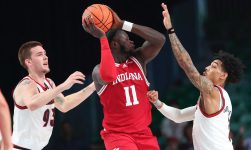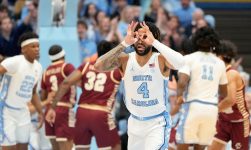Tuesday night, near the end of a lopsided Kansas vs. Kansas State game, a brawl broke out between both teams that cleared the benches, spilled over into the stands and caused a fuss that reverberated across the college hoops landscape. The clock read zeros as havoc was actively breaking loose, leading everyone to believe the game had ended on a Silvio De Sousa swatted shot.
Officials reviewed the play, the subsequent brouhaha and determined that, despite the 81-59 score in favor of KU, 1 second should be added to the game clock. Thus, they added that very minimal amount of time to the contest. De Sousa, KU’s big man, was assessed a technical for taunting on the presumed final play of the game before the melee, which pushed Pierson McAtee to the line to shoot what amounted to game-ending free throws. He went 1 of 2 from the stripe.
Why the game was extended despite being so out of reach for K-State is the hot topic of conversation — and probably some water-cooler debate — but a newly-implemented NCAA rule actually left the officiating crew with no choice but to play out the string. Before we get to why Tuesday’s contest wasn’t immediately ended post-melee, for context, here’s the rule as stated in Section 7, Art. 3c. of the NCAA’s rulebook that previously explained how games could be ended.
c. When a foul occurs so near the expiration of time that the official timer cannot stop the game clock before time expires or when the foul occurs after time expires but while the ball is in flight during a try, the period shall end when the free throw(s) and all related activity have been completed.
After the expiration of time, only those free throw(s) necessary to determine a winner or whether an extra period is necessary shall be awarded.
Beginning in 2019-20, however, a revision to that rule was adopted last June. The NCAA chose to drop the portion of the previous rule that allowed for a judgement call to be made by officials in regards to ending a game. All games must play out the entirety of the 40-minute clock. Its rationale: “To ensure the game concludes with the correct score and other statistics.” Here’s the proposal to the rule that was implemented prior to this season:
“To delete the phrase “and when necessary to determine the outcome of the game” from the current rule.”
So, why bring players just involved in a brawl back onto the court to shoot a pair of free throws? There’s your reasoning. Ending the game is no longer a judgement call left up to the officiating crew no matter the severity of what takes place — it’s simply an NCAA requirement.






